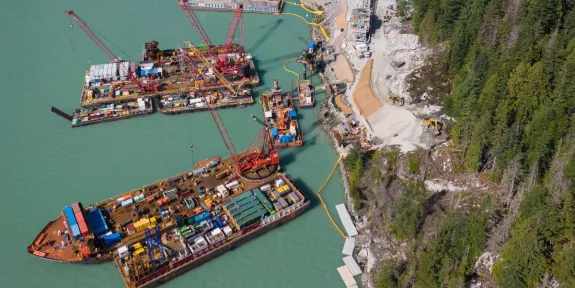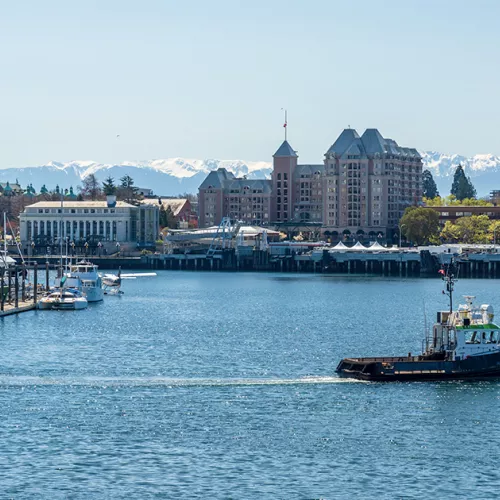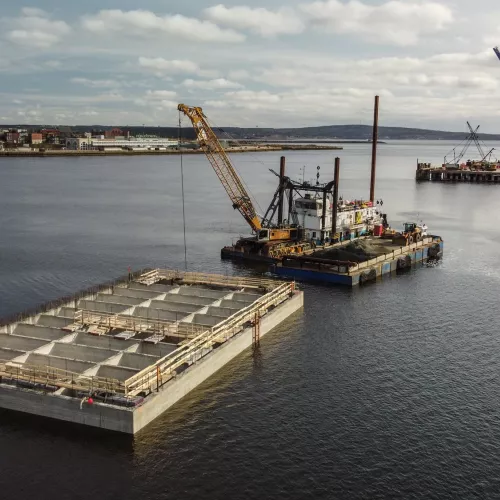
Building the Future of Energy in British Columbia: Woodfibre LNG Facility
- Client
- Woodfibre LNG LTD
- Sector
- Marine Works
- Delivery mode
- Cost Plus
- Location
- Howe Sound, BC, CA
- Year built
- 2027

Located in Howe Sound, British Columbia, the Woodfibre LNG project is a bold step forward in Canada’s energy future. This liquefied natural gas facility will process natural gas for export, while respecting the unique environmental and cultural landscape of the region. Pomerleau, subcontracted by McDermott, is proud to contribute its marine infrastructure and deep foundation expertise to this transformative initiative. Our work includes installing permanent piles, all from a floating worksite equipped with offices and crane barges, some the size of a football field.
Why Pomerleau Was Chosen: Our Marine Works Expertise
Pomerleau was selected for its technical innovation and marine construction expertise. The site presents complex geotechnical challenges, including steep rock faces and unstable seabeds. To address these, our team developed a low-impact piling solution that minimizes disruption to the seabed and reduces the risk of seabed sliding. This approach not only meets the technical demands of the project but also aligns with the environmental sensitivity of the area.
Our specialized expertise in complex underwater piling allows us to work safely and efficiently in fragile marine environments. The installation of marine infrastructure and deep foundations is at the core of our contribution, supporting the LNG facility’s mooring and processing operations. Throughout the project, we maintain strict tidal operations and environmental compliance, adapting our methods to protect marine life and meet regulatory requirements.
Project Delivery and Client Collaboration
The Woodfibre LNG project is delivered under a cost-reimbursable contract with annual renewals. The current agreement runs until March 31, 2026, with discussions underway to extend it through August 2026 and possibly into summer 2027. This flexible model supports a responsive approach, especially on a complex and remote site like Howe Sound.
As a cost-plus project, collaboration is key. Pomerleau works closely with McDermott to manage critical milestones. Our teams regularly propose solutions to emerging challenges, ensuring transparency and alignment throughout the design and construction phases.
Navigating Construction Challenges at Woodfibre LNG
Remote Logistics
Operating in a remote location like Howe Sound means that all materials, equipment, and personnel must be transported by boat. This requires precise coordination and planning to ensure that construction progresses smoothly and safely.
Environmental Regulations
Strict environmental rules govern every aspect of the project. Work must stop immediately when marine mammals such as whales or orcas are observed nearby. These regulations are in place to protect the rich biodiversity of the region, which includes seals, salmon, and herring.
Geotechnical Complexity
The site’s steep slopes and fragile seabed conditions present significant engineering challenges. Our teams have developed specialized piling techniques to ensure stability while minimizing environmental impact.
24/7 Operations
To maintain progress, construction runs around the clock. Crews live on a floating hotel and work in rotating shifts to meet project’s schedule.

Environmental and Cultural Considerations
A Protected Marine Ecosystem
The Woodfibre LNG site is located in Howe Sound, British Columbia, a region recognized as a UNESCO biosphere reserve. This area is home to a rich and diverse marine ecosystem, including humpback whales, orcas, seals, salmon, and herring. Because of this unique setting, environmental protection is a top priority throughout the project. Regular environmental monitoring and reporting are integral to our operations, helping us track impacts and adjust our methods in real time.
Indigenous Leadership and Oversight
The project is also guided by the leadership of the Squamish Nation, which has issued 13 legally binding environmental conditions. Their oversight ensures that construction respects both the natural environment and Indigenous cultural values. This collaboration adds a layer of responsibility and respect that our teams are proud to uphold.
Balancing Progress with Preservation
Working in such a sensitive location means every decision, from logistics to engineering, must balance progress with preservation. It’s a challenge we embrace with care, transparency, and a deep sense of purpose.
Innovation and Sustainability at Work
On the Woodfibre LNG project, innovation and sustainability are deeply embedded in every phase of construction. We use full 4D BIM modeling to visualize the entire site, including floating structures, and to coordinate logistics in real time, ensuring smooth and efficient operations. Our custom-modified vessels, such as the permanently moored barges, are designed to support continuous work in this remote marine environment. To protect the unstable seabed, we’ve developed specialized piling techniques that minimize environmental impact while ensuring structural integrity.
Sustainability is just as central. Excavated soil is treated responsibly, water is removed from mud and treated by a water treatment system before disposal. We also repurpose materials from pile installation and equipment, reducing waste and supporting net zero goals. These innovations reflect our commitment to building infrastructure that respects both nature and the communities it serves.

Heavy-Lifting Marine Equipment on the Woodfibre LNG project
At the Woodfibre LNG construction site, two high-performance marine cranes are driving construction forward. The Arctic Tuk, a 600-ton barge crane built in Japan, offers a 225-foot operating radius and maintains full lifting capacity thanks to its active ballast system. Its hydraulic winches and anchor windlass ensure precision and stability for handling prefabricated components and marine infrastructure.
Alongside it, The Dynamic Beast, delivers unmatched lifting power, to up to 1,400 US tons. With a deck the size of a football field and a impressive ringer crane, it supports 360° operation and complex lifts across a wide radius. Its automated anti-heeling ballast system keeps the barge stable during heavy operations, making it essential for installing mooring structures for floating storage tanks.
Together, these two marine giants offer unparalleled precision, power, and stability, indispensable qualities for this project.
Pomerleau’s Proud Contribution to Woodfibre LNG
At peak activity, the site will host 130 to 140 workers, supported by an off-site management team of over 100. This large-scale LNG construction effort reflects a shared commitment to innovation, sustainability, and responsible development. For Pomerleau, Woodfibre LNG is more than a project, it’s an opportunity to build meaningful infrastructure in one of British Columbia’s most environmentally sensitive regions.
As Senior Project Manager Alexandre Jean puts it, “Working on the Woodfibre LNG project is a rare opportunity to be part of something that’s not only technically challenging, but also deeply meaningful. We’re building critical infrastructure that will serve the region for generations to come, and we’re doing it in one of the most environmentally sensitive areas in the Province. The fact that the Squamish Nation is leading the environmental oversight of the project adds a layer of responsibility and respect that we are very honored to be a part of. Our focus is on doing the work right with care, respect, and collaboration at the forefront of everything we do.”


